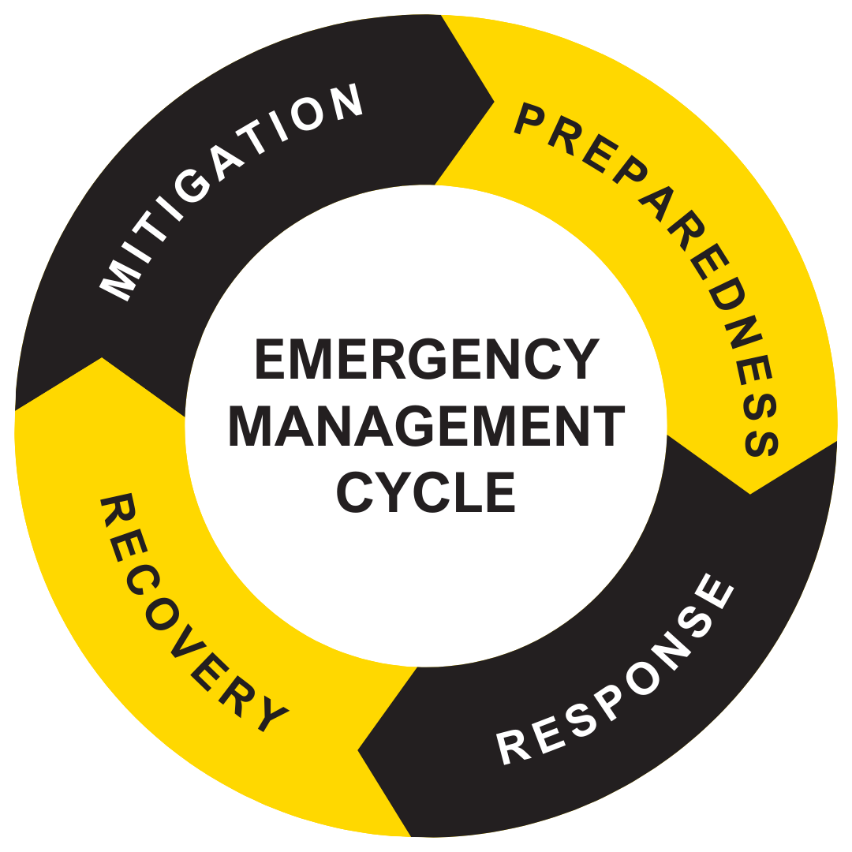
Your Guide Through Emergencies and Disasters
Introduction
Emergency management uses a comprehensive approach to address natural, human-caused, and technological disasters and emergencies. Emergencies and disasters are continuing to increase in their intensity and frequency and can result in human suffering and economic loss. Therefore, your understanding of emergency management is crucial for reducing the impacts you may experience.
Emergency management prepares communities for disasters by reducing vulnerability to hazards and by creating clear plans to support a coordinated response. Effective emergency management reduces impacts on people, property, the environment and the economy while helping us build back better for safer, sustainable and more resilient communities.
Manitoba is focused on the following four key priorities when it comes to emergency management:
- Protect people: Save lives and minimize the impact on people who are affected by the emergency or disaster, including first responders.
- Protect property: Ensure that critical infrastructure, community, and residential property is sustained.
- Protect the environment: Includes air quality, water supplies and other environmental considerations to help maintain a sustainable and enjoyable environment for generations to come.
- Protect the economy: Reduce the economic disruption on a community by ensuring that industry, commerce, and businesses of all sizes are sustained through any emergency or disaster. This resilience is vital to the growth, health, and well-being of Manitoba.
Emergency management is a shared responsibility. Effective emergency management requires a coordinated response from all of the following:
- All levels of government: local authority, provincial, territorial, and federal.
- Businesses.
- Critical service providers and critical infrastructure owners.
- First Nations and Indigenous communities.
- Health authorities.
- Individuals.
- Local community organizations.
- Non-governmental organizations.
- Volunteers.

The emergency management cycle illustrates the ongoing process of mitigation, preparedness, response, and recovery.
The mitigation phase aims to reduce or eliminate loss of life, damage to property and the environment, and economic disruption caused by an emergency or disaster. Effective mitigation is achieved when done in advance to prevent or reduce an emergency and its impacts. This consists of structural (e.g., flood protection dikes or raising homes) and non-structural measures (e.g., land use planning or education).
The preparedness phase is about ensuring the organization is ready when an emergency or disaster hits. This consists of planning, organizing, training, exercising, evaluating, and acting in advance.
The response phase includes the actions taken to manage the impacts during an active emergency or disaster. The goal is to ensure that there is a coordinated, controlled, and effective response.
The recovery phase is the process of repairing or restoring the affected community, business, or family to a reasonable state of normal life after it has been impacted by an emergency or disaster.
The four phases of the emergency management cycle are interconnected and always ongoing. For instance, recovery should begin shortly after response activities are initiated. Mitigation activities start prior to recovery being complete and carry on while preparedness activities are underway.
Emergency programs and plans help communities, organizations and families respond effectively to hazards.
An emergency program oversees all aspects of the emergency management cycle (including the four phases of emergency management). An emergency program guides the strategies, policies, and practices that are utilized at all stages of an emergency or disaster. Any organization can develop an emergency program. However, local authorities are required by legislation to maintain emergency management programs for their communities.
An emergency plan is a document created during the preparedness phase of the emergency management cycle and is referenced during the response phase. An emergency plan should be continuously updated on a regular basis to include any new information on hazards, risks, or vulnerabilities. Everybody, including individuals, businesses, and local authorities should have their own emergency plans.
| Aspect | Emergency Program | Emergency Plan |
|---|---|---|
| Scope | Encompasses all phases of preparedness, response, recovery, and mitigation. | Provides detailed instructions and procedures for responding to a particular emergency or disaster. |
| Purpose | Involves strategies, policies, and practices for building resilience. | Outlines roles, responsibilities, communication protocols, and resource allocation. |
| Focus | Could include training, exercises, and risk assessments. | Designed to address different types of emergencies. |
| Importance | Critical for long-term preparedness and resilience. | Essential for guiding and coordinating response efforts during emergencies or disasters. |
Emergency: A present or imminent event that requires prompt coordination of actions concerning persons or property to protect the health, safety, or welfare of people, or to limit damage to property or the environment. An example of an emergency might include a motor vehicle accident or a power outage.
Disaster: Disasters may be triggered by a naturally occurring hazard which has its origins within the geophysical or biological environment, or by human action or error, whether malicious or unintentional. An example of a disaster might include a wildfire or a flood.
Most emergencies can be managed by first response agencies within a community. Once the disaster threshold is reached resources must be brought in to assist in managing the event, which can take time and worsen an already difficult situation.
The impacts of an emergency or disaster may include loss of life, injury, disease, or other negative effects on human physical, mental, and social well-being. Emergencies and disasters may also include damage to property, destruction of assets, impacts to critical infrastructure, loss of services, social and economic disruption, and environmental degradation.

